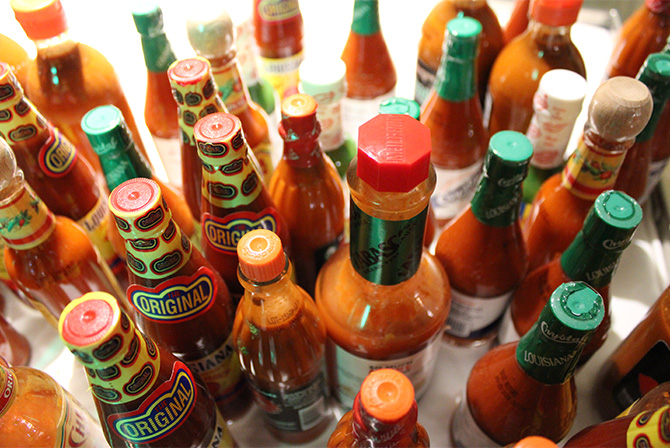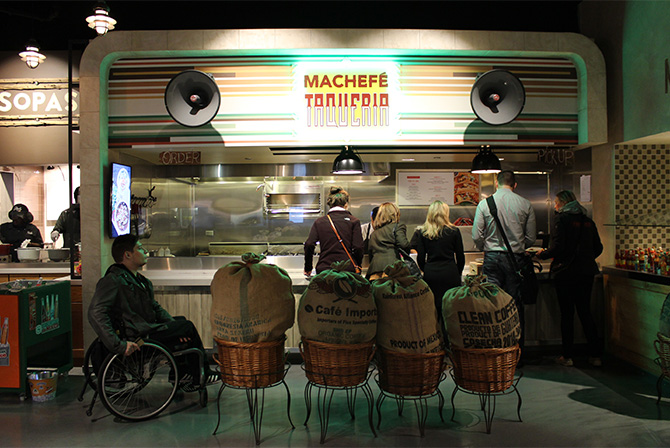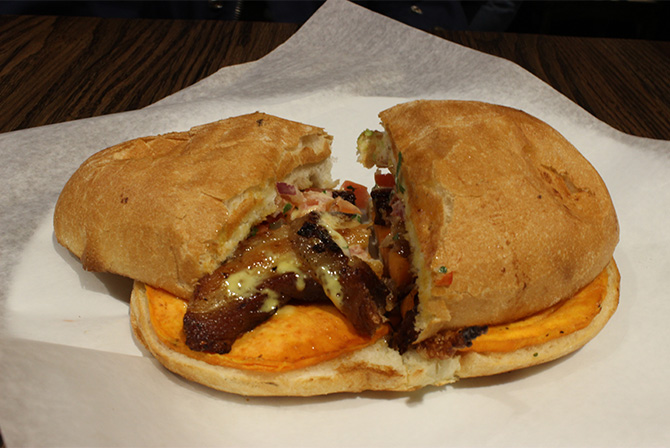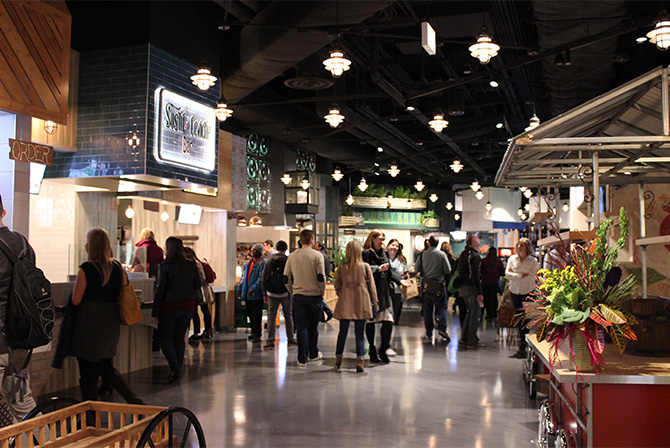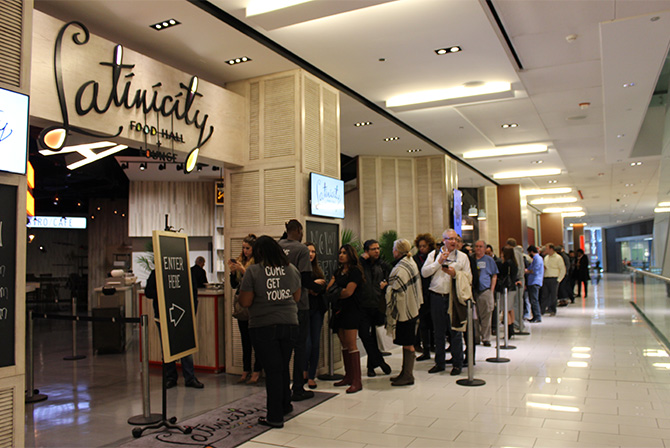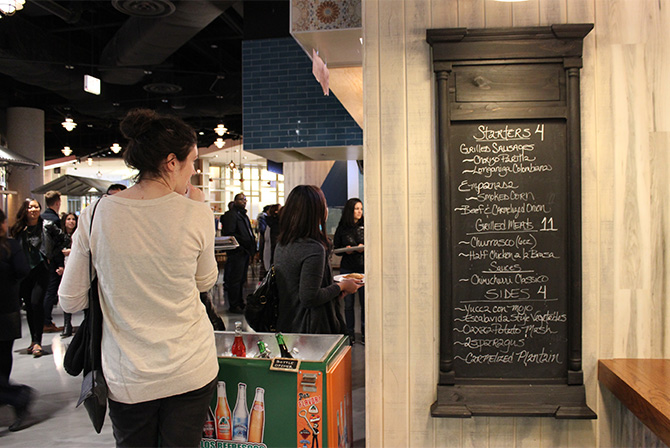It is probably an issue when the best looking dish at a self-styled Latin American food court is the sushi. But that’s exactly what you’ll find at Latinicity, a new, upscale “street food” project from Latin American food tycoon Richard Sandoval. The idea sounds like a great twist on the Eataly concept (a wonderful collection of bars, restaurants and ingredient shops all inside the same store), but the application falls short on many fronts.
Located in Block 37, a mall-in-progress located across the street from Daley Plaza, Latinicity is situated on the third floor, surrounded by empty or under construction rental spaces. The entrance is unassuming, yet gaping, allowing passersby a clean look inside.
As guests enter, they receive a gold swiping card – instead of buying each item, the cost of purchases are placed on the card, and customers pay as they leave.
Past the wide entry, people are presented with two options: enter the full restaurant Pata Negra, or walk down the food court row of eight separate “street food” vendors. The food court is by far the more popular option – Latinicity had to close to restock for a day after 10,000 people visited in the 72 hours after the grand opening.
Options from tortas, tacos, hamburgers, sushi and ceviche, salads and small plates are lined up in a thin hallway, effectively creating a funnel for customers and forcing the impression of a packed street food market anywhere but the third floor of a mall. Each has its own art style made to be highly distinguishable, from chic minimalist posters to a glowing “Burguesa” sign that could have been pulled off a taqueria in Texas.
Past the vendors, the squeezing hallways opens up into a grand dining room and a surprisingly small bar (and a semi-hidden coffee shop that is only easily visible if you’re leaving). Plants hang from the ceiling instead of chandeliers, and the place has room for hundreds of guests, with large booths and smaller tables giving views of Dearborn Street below.
Latinicity had so far presented itself as a spectacle - crowds of people, Mexican skull art and a vibrant little “street” of food stalls. What ultimately caught my full attention, however, was a small sign proclaiming “Tortas, Cocas”. And this is where the experience began to go downhill.
_
If you’ve visited Frontera in Norris, you’ll probably know that tortas are a delicious, beautiful type of Mexican sandwich. I ordered a “Pan con Chicharron”, with “crispy” pork belly, sweet potato, mayonnaise and salsa criolla (onions and tomatoes). For a nine dollar sandwich, I was expecting to watch the lone sandwich maker neatly slice up thick pieces of pork belly and prep my torta in front of my eyes.
Instead, I watched another worker place four, fully cooked thin strips of meat and large slices of sweet potato out of a fridge and onto the front end of a conveyor oven. Oh.
As the makings of my dinner disappeared into the oven to be heated up, I noticed how busy the sandwich maker was plating cocas (I’ll get to those later). He was still busy when the ingredients for my torta reappeared on the cooked side. As they slowly edged closer and closer to the end of the conveyor, I probably could have said something. But I made a judgement call and faced the consequences as my dinner fell off the edge.
Luckily, there was another conveyor three feet below that caught them, and the “plop” of pork belly on metal caught the attention of the sandwich maker, who turned around quickly enough to save my toasted bread from the same fate. In his defense, after he found the ingredients, it only took him 30 seconds to finish my torta.
While all this was going on, I was inches from a glass display case proudly presenting cocas, which looked less like Catalan style flatbread (which is what cocas are, thanks Google) and more like the “Mexican pizza” I was served in elementary school. These were being displayed because, while some were made fresh on order, most were being made and then reheated.
My torta and the pork inside was lukewarm when I got it, it wasn’t filling at all and it was most definitely not “crispy” as advertised - A really “meh” experience. Despite the reheated food, the ugly appearance and the falling meat, Fate forgot one thing while trying to ruin my dinner: Latinicity is a Richard Sandoval restaurant, and they use top-notch ingredients.
The pork was phenomenally slow cooked to a melt-in-your-mouth perfection. This pork belly was so good that I have to assume the pig it came from was raised by a dedicated team who fed it flowers and beer and massaged it twice a day.
At the same time, the flavors just didn’t mix. Crunchy sweet potato discs and pork don’t go together perfectly. I would have eaten each part of my torta individually, but I wouldn’t spend nine dollars to have someone else make it for me again. So even super good ingredients only raised “meh” to “pretty decent”.
Latinicity is a form of entertainment. It’s a pretty thing look at and is kind of fun to try for the first time. Hell, if they called it a bar with street food, I’d have no problem with the quality. Unfortunately, they claim it’s a food court that’s supposed to compare with Eataly, and the food is only pretty good. In reality it’s a more expensive, Latin American-themed Norris.
